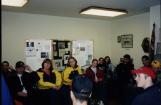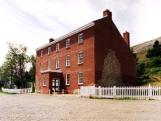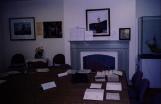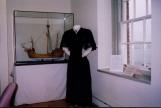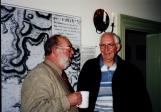

Trinity Museum
Trinity, Newfoundland and Labrador
1
Lester-Garland HouseThis dwelling is built on a fishing property (or Room) once known as Taverner's Plantation. Buildings have stood here since at least 1700. The Taverner family originated in Poole, England and first settled in Newfoundland at Bay de Verde c.1650. The Taverners were the maternal ancestors of both the Lester and the Garland families who later owned this property,
Benjamin Lester, son of Francis Lester of Poole and Rachael (Taverner) Lester, acquired this property in 1748 in a deed of gift, from his father-in-law Jacob Taverner, a distinguished pioneer of Trinity. In the 1760s Benjamin built here a large brick Georgian style dwelling. The centre-piece of a major trading establishment, the Lester Premises became the headquarters of Benjamin Lester and Company, the largest mercantile firm in Newfoundland in the late 18th century.
In the 19th century this property was known as the Garland Plantation. George Garland of Poole became heir to the Lester Premises and Trade by his marriage to Amy Lester, the Trinity-born daughter of Benjamin and Susannah (Taverner) Lester. The Garlands rebuilt or replaced the Lester House in 1819-21 with a large three-storey, Georgian,
brick dwelling. In 1906 the Garland Plantation was purchased by Ryan Brothers.
The large brick Georgian residence built in Trinity by the Poole-Newfoundland merchant, Benjamin Lester, in the 1760s was the first structure of its kind in Newfoundland. Later refurbished, extended and occupied by his grandson, John Bingley Garland, (the first speaker of our House of Assembly), the Lester-Garland House stood as a principal landmark of Trinity Harbour for more than two centuries. The structure was taken down in the 1960s despite the valiant efforts of Trinity Historical Society to preserve the building and others on the property.
The house was reconstructed in 1996/1997 as a museum and education centre to rekindle, promote and celebrate the strong cultural links between Newfoundland and Poole (and the hinterland region known as Wessex in the West of England. It will provide a visible means of interpreting the historic links between these two areas and will also illustrate the role of Trinity, a centre of trade and commerce in the 17th and 18th centuries.
This storyline details the official opening ceremonies of the Lester-Garland House on June 25, 1997, the various rooms of the house and the various educational activities that have taken place at the house since 1997.
4
The Official Opening - The reconstructed Lester-Garland House was officially opened on June 25, 1997. David White gives a few opening remarks.6
The Official Opening , June 25, 1997. The official opening of the Lester-Garland House was completed by Mr. Aiden McGrath, a member of the family to last live in the residence in 1948 and Mr. John Lester-Garland the last of the Garland family.7
The official presentation of the Matthew25 June 1997
Classroom, Exhibit and Meeting Room, Lester-Garland House

8
At the Official Opening, June 25, 1997. The presentation of a model of the Ship Matthew by Sir Anthony Goodenough, British High Commissioner to Canada, to The Trinity Trust-Canada Inc.9
Meeting in the dining room of Lester-Garland House1997
Dining Room, Lester-Garland House, Trinity, Newfoundland

10
A meeting between the Mayor of Poole, Mrs. Annette Brooke, Liberal Democrat Member of Parliament (U.K. - 2002) for Mid Dorset and North Poole and the Mayor of Trinity, David R. L. White in September, 1997 in the Dining Room of Lester-Garland House.11
The Reconstructed/Restored House - the Front Entry in 1998.1998
Lester-Garland House, Trinity, Newfoundland
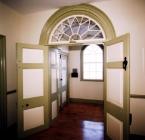
12
The Main EntranceThe original fanlight window, interior doors and door knocker are from the 1819 house.
13
The Reconstructed/Restored House - the Hearth of c. 1748 in 1998.1998
Lester-Garland House, Trinity, Newfoundland
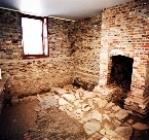
14
The Reconstruction RoomWhile excavating under the area of the living room of the 1819 house, archaeologists discovered remains of an older dwelling. These consisted of a brick hearth, part of a dry laid stone chimney and the external perimeter foundation of a corner of the earlier structure. This suggests that an older structure was dismantled to make way for the 1819 house. In developing the conservation philosophy for the house, The Trinity Trust decided that visitors should be able to view not only the older hearth and foundations, but also the stone foundations, the remaining brick end wall including the adhering lath and plaster, the fireplace foundations and chimney, the nailing boards inserted in the walls and replicas of the window shutters of the 1819 structure. This room is an exhibit of construction techniques of the period.
15
The Reconstructed/Restored House - the Dining Room in 1998.1998
Lester-Garland House, Trinity, Newfoundland
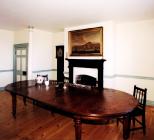
16
The Dining RoomShows the original mantelpiece, the Lester table, a painting of the Lester fleet in Trinity Harbour, c.1795, Garland Family silver and jug and the Jolliffe-Vallis clock.
17
The Reconstructed/Restored House - the Reading/Research Room in 1998.1998
Lester-Garland House, Trinity, Newfoundland
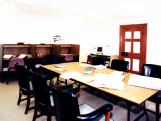
18
The Reading RoomA Wessex Learning Centre facility, the Reading / Research Room will partially house the Education Program which will focus on subject areas particular to Trinity's historical resources from 1579 to the present, and explore the strong connection between Trinity and England's West Country.
19
The Reconstructed/Restored House - the Classroom, Exhibit and Meeting Room in 1998.1998
Lester-Garland House, Trinity, Newfoundland
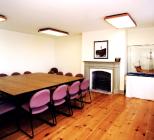
20
The ClassroomThe Display and Travelling Exhibits Room is a modern museum space for locally prepared exhibitions and displays as well as for exchanges of these with national and international groups. The area may also be used as a classroom/meeting room and is available for rent to outside groups and organizations who may wish to meet "somewhere different".
21
Lakecrest students visit the reconstructed/restored house1997
Lester-Garland House, Trinity, Newfoundland
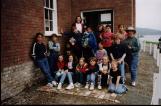
22
Uses of the Reconstructed/Restored House - Visits by School Groups - Lakecrest School, St. John's, 1997.23
Uses of the Reconstructed/Restored House - Children's Day - 1999.1998
Lester-Garland House, Trinity, Newfoundland
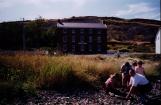
24
Uses of the Reconstructed/Restored House - Children's Day - 199927
Uses of the Reconstructed/Restored House - Visits by School Groups - Some school children from Clarenville enjoying their lunch after a tour of the Lester-Garland House.29
Uses of the Reconstructed/Restored House - Meetings -Joint Members of The Trust and Historical Society following a meeting in Lester-Garland House, 1998.31
Uses of the Reconstructed/Restored House - Special Exhibits - Pittman Family Reunion Display in 1999.34
Uses of thje Reconstructed/Restored House - Receptions - Reception after the M. M. White Lecture in 199935
Historical Society members meet after the M.M. White Lecture5 October 2000
Reception after the MM White Lecture, Lester-Garland House

36
Uses of the Reconstructed/Restored House - Receptions - a conversation among members of the Bonavista and Trinity Historical Societies on the second floor of the Lester-Garland House during the reception after the M. M. White Lecture in 2000.37
Chatting after the lecture5 October 2000
Classroom, Exhibit and Meeting Room, Lester-Garland House
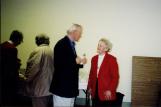
38
Uses of the Reconstructed/Restored House - Receptions - Dr. Paul O'Neill, Lecturer, and Guest Miss. Catherine McGrath chat following the 2000 M. M. White Memorial Lecture.41
Bishop White students at World Wars I and II Display9 November 2001
Classroom, Exhibit and Meeting Room, Lester-Garland House
